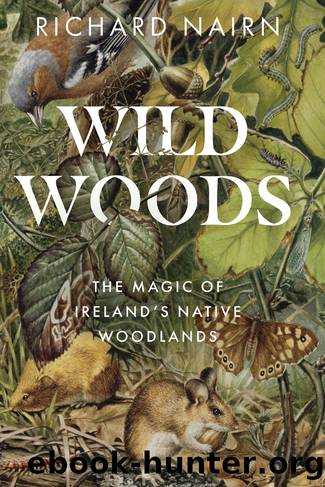Wildwoods: The Magic of Ireland's Native Woodlands by Richard. Nairn

Author:Richard. Nairn [Nairn, Richard.]
Language: eng
Format: epub
ISBN: 9780717190218
Google: lBijzQEACAAJ
Publisher: Gill Books
Published: 2020-11-15T00:16:30.712551+00:00
Kite flying
As I approach the wood in the dawn light, a distinctive shape lifts off from the tallest tree. Long, pointed wings, a deeply forked tail and an overall red colour identifies it as a red kite. Harried by the local pair of hooded crows, it drifts lazily off across the fields, circling in the morning mist as it struggles to gain height. A red kite, like the familiar childrenâs kite, seems to fly without any effort, gliding away on the updrafts and steering with its flexible tail. I have seen these exciting birds numerous times across Wicklow, but only recently in our own woodland. The red kite was once common across Britain and Ireland and there are even several Old Irish names for the species including phreachain na gclearc or préachán ceirteach. The latter name translates literally as âcloth kiteâ, referring to the birdsâ habit of decorating their nests with cloths and rags. But, like most of the predatory birds in Ireland, the red kite was persecuted and eventually wiped out here in the eighteenth century. Ned, the previous owner of our wood, never saw a red kite as they were long gone from Ireland when he farmed here in the late 1800s. These are inspirational birds whose decline and eventual extinction here mirrors the fortunes of our native woodlands.
In 2007 the Golden Eagle Trust launched an innovative project to reintroduce red kites to Ireland. The nearest surviving population was in the mountains of central Wales where they had hung on for centuries in the remote mountain valleys and woodlands. The decline of this remnant population began to change in the late twentieth century when numbers increased to over 1,000 pairs. So, it was to Wales that members of the Golden Eagle Trust (supported by the NPWS) went in search of a donor population that could be used to re-establish red kites in Wicklow, just eighty kilometres across the Irish Sea. Under licence and with the help of local ornithologists from the Welsh Kite Trust, they climbed numerous trees to seek out nests with three or more red kite chicks from which a single bird was removed before fledging. After veterinary clearance the young birds were rushed to their new homes and placed in release cages at a quiet location in the centre of Wicklow. Here they were reared with a minimum of human contact until the great day came when the doors of the cages were left open and these magnificent birds took to the Irish skies for the first time in over two centuries.
Wicklow was chosen for the first releases because it most closely resembled the landscape of Wales where the birds had managed to eke out an existence. This county is one of the most wooded in Ireland and has an intimate mix of lowland farmland habitats with plenty of hedgerow trees and small woodlands. From then on, annual releases of a total of 120 kites helped to supplement the population although not all the young birds survived.
Download
This site does not store any files on its server. We only index and link to content provided by other sites. Please contact the content providers to delete copyright contents if any and email us, we'll remove relevant links or contents immediately.
Harry Potter and the Goblet Of Fire by J.K. Rowling(3112)
Never by Ken Follett(2926)
Unfinished: A Memoir by Priyanka Chopra Jonas(2925)
Machine Learning at Scale with H2O by Gregory Keys | David Whiting(2339)
The Man Who Died Twice by Richard Osman(2320)
Fairy Tale by Stephen King(2111)
Will by Will Smith(2088)
Rationality by Steven Pinker(1785)
The Storyteller by Dave Grohl(1680)
The Dark Hours by Michael Connelly(1592)
The Dawn of Everything: A New History of Humanity by David Graeber & David Wengrow(1586)
The Stranger in the Lifeboat by Mitch Albom(1571)
Cloud Cuckoo Land by Anthony Doerr(1457)
New Morning Mercies: A Daily Gospel Devotional by Paul David Tripp(1413)
Friends, Lovers, and the Big Terrible Thing by Matthew Perry(1360)
The Becoming by Nora Roberts(1350)
Crying in H Mart by Michelle Zauner(1345)
Einstein: His Life and Universe by Walter Isaacson(1330)
A Short History of War by Jeremy Black(1314)
